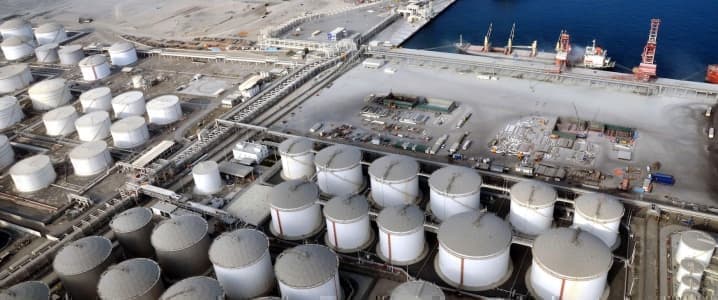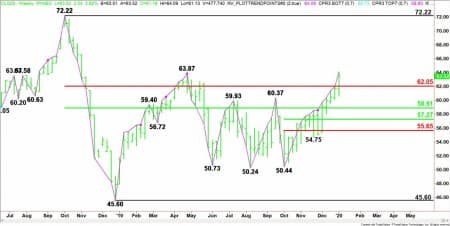U.S. West Texas Intermediate and international-benchmark Brent crude oil futures hit their highest levels since April on Friday after the killing of a top Iranian general sparked fears of a broader conflict that could disrupt the energy supply and drag down the global economy.
Short-covering and aggressive speculative buying drove crude oil prices sharply higher after the U.S. airstrike ordered by President Donald Trump killed Iran’s top general, Qasem Soleimani, in Baghdad. Soleimani had been a key figure in Iranian politics, and his death has raised concerns over a potential retaliation from the Iranian forces.
So far there has not been a disruption in supply so gains have been limited. However, Iran has vowed to retaliate. Previous aggressive activity has included bombing a Saudi Arabian production facility and attacking oil tankers.
Shortly after the attack, Iranian Foreign Minister Mohammad Javad Zarif warned Friday that the targeted killing of Soleimani was “extremely dangerous & a foolish escalation.”
“The U.S. bears responsibility for all consequences of its rogue adventurism,” Zarif said on Twitter.
Prior to the jump in prices on Friday, the markets were being underpinned by traditional supply and demand fundamentals that controlled the price behavior from December 1 until the end of the year.
Short-Term Factors Supporting Crude Oil
A thaw in U.S.-China trade relations is raising hopes for increased demand growth, while…
U.S. West Texas Intermediate and international-benchmark Brent crude oil futures hit their highest levels since April on Friday after the killing of a top Iranian general sparked fears of a broader conflict that could disrupt the energy supply and drag down the global economy.
Short-covering and aggressive speculative buying drove crude oil prices sharply higher after the U.S. airstrike ordered by President Donald Trump killed Iran’s top general, Qasem Soleimani, in Baghdad. Soleimani had been a key figure in Iranian politics, and his death has raised concerns over a potential retaliation from the Iranian forces.
So far there has not been a disruption in supply so gains have been limited. However, Iran has vowed to retaliate. Previous aggressive activity has included bombing a Saudi Arabian production facility and attacking oil tankers.
Shortly after the attack, Iranian Foreign Minister Mohammad Javad Zarif warned Friday that the targeted killing of Soleimani was “extremely dangerous & a foolish escalation.”
“The U.S. bears responsibility for all consequences of its rogue adventurism,” Zarif said on Twitter.
Prior to the jump in prices on Friday, the markets were being underpinned by traditional supply and demand fundamentals that controlled the price behavior from December 1 until the end of the year.
Short-Term Factors Supporting Crude Oil
A thaw in U.S.-China trade relations is raising hopes for increased demand growth, while renewed tensions in the Middle East have raised red flags over potential supply problems.
WTI and Brent crude oil ended higher in 2019, posting their biggest annual gains since 2016, buoyed at the end of the year by a thaw in the prolonged trade war between the United States and China and a deeper output cut pledged by OPEC and its allies. However, keep in mind the performance is deceiving because the move took place after a steep drop in prices between October and December 2018.
Deeper Production Cuts Began January 1
As promised in late November/early December, OPEC and its allies, including Russia have begun cutting another 500,000 barrels per day (bpd) of crude oil, on top of their previous cut of 1.2 million bpd that started on January 1, 2019.
Trade Deal Update
U.S. President Donald Trump said on Tuesday the U.S.-China Phase 1 trade deal would be signed on January 15 at the White House. Hopefully, many of the details of the deal will also be revealed at that time since this has been a major concern for some investors. Additionally, there has been no word on when Phase 2 negotiations will begin.
Weekly Inventories Expectations
Official weekly inventories data from the Energy Information Administration (EIA) is due to be released on Friday at 16:00 GMT. Traders are looking for a draw of 3.1 million barrels.
Late Tuesday, the American Petroleum Institute (API) reported a drop in U.S. crude stocks by 7.8 million barrels in the week ended December 27, compared with analysts’ expectations for a decrease of 3.2 million barrels.
2020 Forecast
In 2020, Brent is forecast to average $63.07 a barrel, up from December’s estimate of $62.50, while WTI is forecast to average $57.70 a barrel, up from December’s estimate of $57.30, as the OPEC-led supply cuts and the expectations of a U.S.-China trade deal boosted analysts’ views on the prospects for the year, a Reuters poll showed.
Technical Analysis
Weekly February West Texas Intermediate Crude Oil Technical Analysis

Weekly Trend indicator
The main trend is up according to the weekly swing chart. The uptrend was reaffirmed on January 3 when buyers took out the main top from the week-ending April 26 at $63.87.
The main trend will change to down on a trade through $50.44. This is extremely unlikely, but due to the prolonged move up in terms of price and time, the best sign of a top will be a higher-high, lower-close chart pattern, also known as a closing price reversal top.
The main range is $72.22 to $45.60. Its retracement zone at $62.05 to $58.91 is controlling the longer-term direction of the market. The nearest support is the Fibonacci level at $62.05, followed by the 50% level at $58.91.
The new short-term range is $50.44 to $64.09. Its retracement zone at $57.27 to $55.65 is also support. This zone also represents value so any pullback into this area is likely to be attractive to buyers.
Weekly Trend Indicator Forecast
Based on this week’s price action, the direction of the February WTI crude oil market the week-ending January 10 is likely to be determined by trader reaction to the main Fibonacci level at $62.05.
Bullish Scenario
A sustained move over $62.05 will indicate the presence of buyers. A sustained move over the former main top at $63.87 will indicate the buying is getting stronger.
The weekly chart shows there is plenty of room to the upside over $63.87 with $72.22 the next major upside target. So don’t be surprised by an acceleration to the upside.
Bearish Scenario
A sustained move under $62.05 will signal the return of sellers. This won’t change the trend to down, but it will indicate the selling is greater than the buying at current price levels. This usually is caused by an overbought market that tends to indicate investor unwillingness to chase the market higher. This means they are looking for value.
The first value zone is $62.05 to $58.91. The second value zone is $58.91 to $57.27 and the third comes in at $57.27 to $55.65.
Conclusion
The big questions for investors are will there be retaliation from Iran and when will it happen? Even before the U.S. attack, the Pentagon said Iran had been planning attacks on U.S. interests in the Middle East. Crude oil prices jumped early Friday as speculators bet on a possible disruption in oil supply from the region. The markets are not likely to move much behind Friday’s high until traders see oil spilling or on fire on their computer screens and TVs.
Remember what happened in the market after the attacks on Saudi production facilities in September. The market initially spiked higher, but prices began to fall after the damage was assessed. Basically, “no oil spilled, no significant rally”.
Ahead of the week-end, it remains very unclear exactly what impact the U.S. strikes could have on the crude oil market. It is significant that one of Iran’s top military generals was taken out … but the next move in crude oil hinges upon what Iran does in terms of retaliation.



















these Bstrds are killing Mexicans, cjle boliva for silver, copper, lithium etc eling mexico for silver,
Africa for gold/ uranium. only god will kill these bastards soon..
And they claim to be money managers with $1.5 trillion surplus cash. what a joke. these barbarians Bush and his crime lords in d.c. running consulting firms -Blackstone, Carlyle. these people are pimps.
they hv prostitutes from India also.
entire silicon valley starting fomr oracle inc should be boycotted and IMF, U.N and WHO should be demolished. these free loaders.